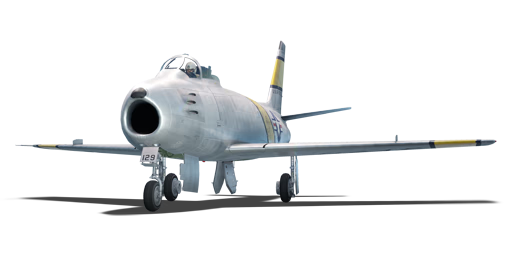

Aviation
F-86F-25
V
Rank
AB
7.7
RB
8.3
SB
8.7
Battle rating
USA
Research country
Fighter
Main role
61,000

Research
340,000

Purchase
General information
Flight performance
Max speed
at 0 m
1,1061,0881,1161,095 km/h
Rate of Climb
46.735.756.738.7 m/s
Turn time
2425.922.625.5 s
Max altitude
14,700 m
Takeoff Run
750 m
Landing
flaps
flaps
Take-off
flaps
flaps
Combat
flaps
flaps
Air
brake
brake
General characteristics
Crew
1 person
Engine
Length
11.4 m
Wingspan
12 m
Wing Loading
242 kg/m²
Weight:
Base weight
5.535.715.395.68 t
Fuel in main tanks
1.29 t (26m)
Limits:
Max Speed Limit (IAS)
1,170 km/h
Mach Number Limit
1.2 M
G limit
≈ -6/12 G
Flap Speed Limit (IAS)
L / T / C
350 / 551 / 590 km/h
Gear Speed Limit (IAS)
350 km/h
Offensive armament
6 × 12.7 mm M3 Browning machine gun
Ammunition
1,800 rounds
Fire rate
1,200 shots/min
One-second Burst Mass
0.86 kg
| Belt | Belt filling | Armor penetration (mm) at a distance: | |||||
|---|---|---|---|---|---|---|---|
| 10 m | 100 m | 500 m | 1000 m | 1500 m | 2000 m | ||
| API-T/AP/AP/I | 30 | 27 | 20 | 13 | 9 | 6 | |
| AP-I/AP-I/API-T/I/I | 28 | 26 | 18 | 11 | 7 | 4 | |
| API-T/I/AP/AP/AP-I/AP-I | 30 | 27 | 20 | 13 | 9 | 6 | |
| API-T | 28 | 26 | 18 | 11 | 7 | 4 | |
| AP-I/I/AP-I/I | 28 | 26 | 18 | 11 | 7 | 4 | |
Suspended armament
Setup 1
8 × HVAR rockets
8 × HVAR rockets
8 × HVAR rockets
Setup 2
2 × 750 lb M117 cone 45 bomb
Setup 3
2 × 1000 lb AN-M65A1 Fin M129 bomb
Economy
Repair cost
Basic → Reference
AB
3,540 → 4,747 

RB
9,098 → 12,200 

SB
10,381 → 13,921 

Crew training
98,000 

Experts
340,000 

Aces
1,800 

Research Aces
780,000 

Reward multiplier
AB / RB / SB
130 / 380 / 600 % 

202 % 

Total cost of modifications
101,800 

163,000 

Talisman cost
2,200 

Research order:
Flight performance | |
|---|---|
Survivability |
|---|
Weaponry | |
|---|---|
Rating by players
You must play more than 3 battles for the last week and more than 10 battles in a vehicle to rate it.
Like:
24
Flight performance:
Not enough ratings
Survivability:
Not enough ratings
Aerial combat:
Not enough ratings
Ground attack:
Not enough ratings
Balance:
Not enough ratings
Tips & Tricks
This space is currently empty
Do you know any interesting vehicle features?
Loading...
No articles about this vehicle yet
Become the first author and get rewards!
Write a guide, tell about interesting historical facts, make a tutorial or simply an interesting post.
No more content